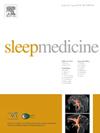Trends in nighttime insomnia symptoms in Canada from 2007 to 2021
IF 3.8
2区 医学
Q1 CLINICAL NEUROLOGY
引用次数: 0
Abstract
Objective
National estimates and trends in insomnia symptoms in Canada are outdated. Updates are needed to inform the development of targeted prevention and intervention strategies. This study aimed to examine the prevalence and trends in nighttime insomnia symptoms among Canadians aged 12 years and older between 2007 and 2021.
Methods
The Canadian Community Health Survey (CCHS), a nationally representative, repeated cross-sectional survey was used. Nighttime insomnia symptoms were self-reported and defined as trouble going to sleep or staying asleep most or all of the time.
Results
This study included data from 197,469 participants. Nighttime insomnia symptoms in Canadians have remained relatively stable from 2007 to 2021, with higher prevalence in adults (18–20 %), particularly women (19–24 %), and those with a medium level of education defined as secondary school graduation (16–21 %). However, nighttime insomnia symptoms became 1.24-fold more prevalent from 2007 to 2021 among women aged 18–64 years (19.3 % vs. 24.0 %) and 1.33-fold more prevalent among those with a medium level of education (15.9 % vs. 21.2 %). Nighttime insomnia symptoms were roughly two times more prevalent in individuals with poorer self-perceived general health, mental health, and life satisfaction compared to those with better self-perception. The prevalence of nighttime insomnia symptoms among those with poor general health increased 1.18-fold from 23.8 % in 2007 to 28.1 % in 2021.
Conclusions
Over this 14-year period, nighttime insomnia symptoms have remained consistently high in Canada, but have increasingly affected certain subgroups. Targeted efforts are needed to address this issue in the most affected segments of the population.
2007 至 2021 年加拿大夜间失眠症状的变化趋势
目标 加拿大对失眠症状的全国性估计和趋势已经过时。需要对其进行更新,以便为制定有针对性的预防和干预策略提供信息。本研究旨在调查 2007 年至 2021 年期间 12 岁及以上加拿大人夜间失眠症状的流行情况和趋势。方法 采用加拿大社区健康调查 (CCHS),这是一项具有全国代表性的重复横断面调查。夜间失眠症状为自我报告,定义为大部分或全部时间难以入睡或无法入睡。从 2007 年到 2021 年,加拿大人的夜间失眠症状一直保持相对稳定,成年人(18-20%),尤其是女性(19-24%)和中等教育水平(即中学毕业)人群(16-21%)的夜间失眠症状发生率较高。然而,从 2007 年到 2021 年,夜间失眠症状在 18-64 岁女性中的流行率增加了 1.24 倍(19.3% 对 24.0%),在中等教育水平人群中的流行率增加了 1.33 倍(15.9% 对 21.2%)。与自我感觉较好的人相比,自我感觉较差的人在一般健康、心理健康和生活满意度方面的夜间失眠症状发生率大约高出两倍。在总体健康状况较差的人群中,夜间失眠症状的流行率从 2007 年的 23.8% 增加到 2021 年的 28.1%,增加了 1.18 倍。需要采取有针对性的措施,解决受影响最严重人群的这一问题。
本文章由计算机程序翻译,如有差异,请以英文原文为准。
求助全文
约1分钟内获得全文
求助全文
来源期刊

Sleep medicine
医学-临床神经学
CiteScore
8.40
自引率
6.20%
发文量
1060
审稿时长
49 days
期刊介绍:
Sleep Medicine aims to be a journal no one involved in clinical sleep medicine can do without.
A journal primarily focussing on the human aspects of sleep, integrating the various disciplines that are involved in sleep medicine: neurology, clinical neurophysiology, internal medicine (particularly pulmonology and cardiology), psychology, psychiatry, sleep technology, pediatrics, neurosurgery, otorhinolaryngology, and dentistry.
The journal publishes the following types of articles: Reviews (also intended as a way to bridge the gap between basic sleep research and clinical relevance); Original Research Articles; Full-length articles; Brief communications; Controversies; Case reports; Letters to the Editor; Journal search and commentaries; Book reviews; Meeting announcements; Listing of relevant organisations plus web sites.
 求助内容:
求助内容: 应助结果提醒方式:
应助结果提醒方式:


